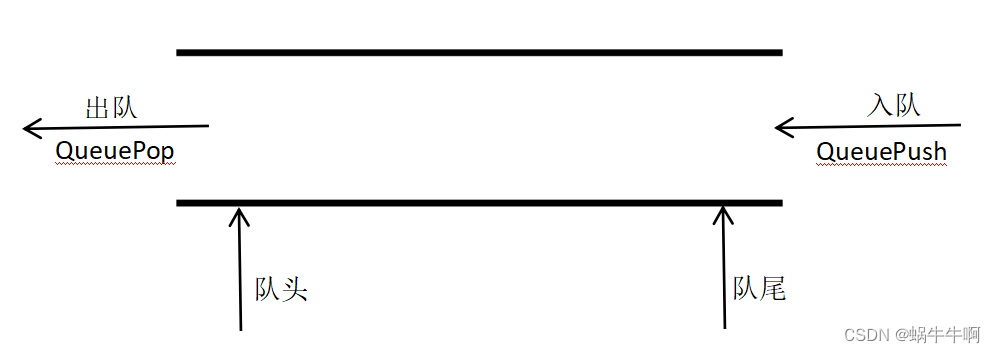🚀 作者简介:一名在后端领域学习,并渴望能够学有所成的追梦人。
🐌 个人主页:蜗牛牛啊
🔥 系列专栏:🛹数据结构、🛴C++
📕 学习格言:博观而约取,厚积而薄发
🌹 欢迎进来的小伙伴,如果小伙伴们在学习的过程中,发现有需要纠正的地方,烦请指正,希望能够与诸君一同成长! 🌹
一、概念和结构
队列只允许在一端进行插入数据操作,在另一端进行删除数据操作的特殊线性表,队列具有先进先出FIFO(First In First Out) 。
入队列:进行插入操作的一端称为队尾 。
出队列:进行删除操作的一端称为队头。
二、基本操作的实现
定义结构体:
typedef int QDataType;
//队列中结点
typedef struct QueueNode
{
QDataType val;//结点值
struct QueueNode* next;//指向下一个结点的指针
}QNode;
typedef struct Queue {
QNode* head;//队列头结点的指针
QNode* tail;//队列尾结点的指针
int size;//队列中元素个数
}Queue;
1.初始化
void QueueInit(Queue* pq)//初始化
{
assert(pq);
pq->head = pq->tail = NULL;
pq->size = 0;
}
2.判断是否为空
bool QueueEmpty(Queue* pq)//判断是否为空
{
assert(pq);
return pq->head == NULL && pq->tail == NULL; //当队列头节点的指针和尾结点的指针都为空时队列为空
}
3.入队
void QueuePush(Queue* pq, QDataType x)//入队
{
assert(pq);
QNode* newnode = (QNode*)malloc(sizeof(QNode)); //创建节点
if (newnode == NULL)
{
perror("malloc");
exit(-1);
}
//将节点赋值
newnode->val = x;
newnode->next = NULL;
//当队列为空时
if (pq->head == NULL)
{
pq->head = pq->tail = newnode;
}
//当队列不为空时
else
{
pq->tail->next = newnode;
pq->tail = newnode;
}
pq->size++;
}
入队时判断当队列为空时
pq->head = pq->tail = NULL,不能对pq->tail解引用。
4.出队
void QueuePop(Queue* pq)//出队列
{
assert(pq);
assert(!QueueEmpty(pq)); //判断队列是否为空
//当队列中只剩一个结点时
if (pq->head->next == NULL)
{
free(pq->head);//释放节点
pq->head = pq->tail = NULL;//队列置空
}
//队列中有多个结点时
else
{
QNode* cur = pq->head;//记录下一个节点
pq->head = cur->next;
free(cur);//释放头节点
}
pq->size--;//有效个数--
}
出队时要判断队列是否为空,
assert(!QueueEmpty(pq))。
5.打印
void QueuePrint(Queue* pq)//打印
{
assert(pq);
QNode* cur = pq->head;
while (cur)
{
printf("%d ", cur->val);
cur = cur->next;
}
printf("\n");
}
注意循环条件
while (cur),不能写为while(cur!=pq->tail)。
6.返回队头的值
QDataType QueueFront(Queue* pq)//返回队头的值
{
assert(pq);
assert(!QueueEmpty(pq));
return pq->head->val;
}
7.返回队尾的值
QDataType QueueBack(Queue* pq)//返回队尾的值
{
assert(pq);
assert(!QueueEmpty(pq));
return pq->tail->val;
}
8.统计队列中有效值个数
int QueueSize(Queue* pq)//返回队列中有效值个数
{
assert(pq);
//int size = 0;
//QNode* cur = pq->head;
//while (cur)
//{
// size++;
// cur = cur->next;
//}
//return size;
return pq->size;
}
9.销毁
void QueueDestroy(Queue* pq)//销毁
{
assert(pq);
QNode* cur = pq->head;
//遍历,一个一个的释放空间
while (cur)
{
QNode* del = cur->next;
free(cur);
cur = del;
}
pq->head = pq->tail = NULL;//置空
}
三、测试代码
#include <stdio.h>
#include <stdbool.h>
#include <stdlib.h>
#include <assert.h>
typedef int QDataType;
typedef struct QueueNode
{
QDataType val;
struct QueueNode* next;
}QNode;
typedef struct Queue {
QNode* head;
QNode* tail;
int size;
}Queue;
void QueueInit(Queue* pq)//初始化
{
assert(pq);
pq->head = pq->tail = NULL;
pq->size = 0;
}
void QueueDestroy(Queue* pq)//销毁
{
assert(pq);
QNode* cur = pq->head;
while (cur)
{
QNode* del = cur->next;
free(cur);
cur = del;
}
pq->head = pq->tail = NULL;
}
void QueuePrint(Queue* pq)//打印
{
assert(pq);
QNode* cur = pq->head;
while (cur)
{
printf("%d ", cur->val);
cur = cur->next;
}
printf("\n");
}
bool QueueEmpty(Queue* pq)//判断是否为空
{
assert(pq);
return pq->head == NULL && pq->tail == NULL;
}
void QueuePush(Queue* pq, QDataType x)//入队
{
assert(pq);
QNode* newnode = (QNode*)malloc(sizeof(QNode));
if (newnode == NULL)
{
perror("malloc");
exit(-1);
}
newnode->val = x;
newnode->next = NULL;
if (pq->head == NULL)
{
pq->head = pq->tail = newnode;
}
else
{
pq->tail->next = newnode;
pq->tail = newnode;
}
pq->size++;
}
void QueuePop(Queue* pq)//出队列
{
assert(pq);
assert(!QueueEmpty(pq));
if (pq->head->next == NULL)
{
free(pq->head);
pq->head = pq->tail = NULL;
}
else
{
QNode* cur = pq->head;
pq->head = cur->next;
free(cur);
}
pq->size--;
}
QDataType QueueFront(Queue* pq)//返回队头的值
{
assert(pq);
assert(!QueueEmpty(pq));
return pq->head->val;
}
QDataType QueueBack(Queue* pq)//返回队尾的值
{
assert(pq);
assert(!QueueEmpty(pq));
return pq->tail->val;
}
int QueueSize(Queue* pq)//返回队列中有效值个数
{
assert(pq);
//int size = 0;
//QNode* cur = pq->head;
//while (cur)
//{
// size++;
// cur = cur->next;
//}
//return size;
return pq->size;
}
void TeseQueue()
{
Queue q;
QueueInit(&q);
QueuePush(&q, 1);
QueuePush(&q, 2);
QueuePush(&q, 3);
QueuePush(&q, 4);
QueuePush(&q, 5);
QueuePop(&q);
QueuePop(&q);
QueuePop(&q);
QueuePop(&q);
QueuePrint(&q);
printf("%d\n", QueueFront(&q));
printf("%d\n", QueueBack(&q));
if(!QueueEmpty(&q))
printf("%d\n", QueueSize(&q));
QueueDestroy(&q);
}
int main()
{
TeseQueue();
return 0;
}
























 231
231











 被折叠的 条评论
为什么被折叠?
被折叠的 条评论
为什么被折叠?










